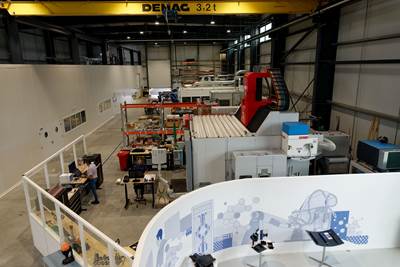Composites reinvent infrastructure
Celebrating National Composites Week, CW shares ways in which composites continue to evolve the way we approach infrastructure projects.

Source | NREL; Creative Composites Group; Sireg Geotech; RPC Technologies
In the realm of infrastructure development, the unique properties of composite materials — such as durability, lightweight and environmental sustainability — make them an increasingly attractive option for modern construction.
One of the most significant advantages of composite materials in infrastructure is their exceptional durability. Traditional materials like steel and concrete are prone to corrosion and degradation over time, particularly in harsh environments. Composites, on the other hand, are highly resistant to corrosion, chemicals, and weathering. This resistance significantly extends the lifespan of structures, reducing the need for frequent maintenance and repairs.
The lightweight nature of composite materials translates into numerous advantages for infrastructure applications. Despite being significantly lighter than traditional materials, composites can offer comparable or even superior strength. This weight-to-strength ratio is particularly beneficial in infrastructure projects where reducing weight can lead to cost savings in transportation, installation and support structures. For example, composite materials are being used in the construction of modular buildings, where their lightweight properties facilitate easier transportation and assembly.
While the initial cost of composite materials may be higher than that of traditional materials, there is evidence for their long-term economic benefits. The reduced need for maintenance, longer lifespan, and potential for modular construction contribute to significant cost savings over time. For instance, in the case of bridge construction, the use of composites can lead to reduced maintenance costs and extended service life, resulting in a lower total cost of ownership.
For National Composites Week, CW is providing daily roundups starring some of the prominent end markets in which composite materials greatly contribute. Each roundup comprises relevant published content to explore and read.
Note: Below covers only 2023-2024 articles for these topics. For other related content (including news and products), please visit CW’s markets page.
Wind energy
CW Talks discusses Ford Motor Company’s involvement with the EMPHASIZING project, a UK consortium working to develop a material from recycled glass fiber with mechanical properties superior to virgin glass.
Research enables successful automation in post-molding manufacturing operations, which could lead to more competitive U.S.-based blade manufacturing.
Utility
EasyStreet Systems is working with Exel Composites to develop and certify pull-wound fiberglass utility poles aimed at durable, lightweight poles for 5G small cell systems.
Metromont’s C-GRID-reinforced insulated precast concrete’s high strength, durability, light weight and ease of installation improve data center performance, construction time and sustainability.
Texas-based Champion Fiberglass, a five-time CW Top Shops honoree, expands its success in the fiberglass composite conduit market into new applications and products, looking toward future automation and sustainability initiatives.
About National Composites Week
The goal of National Composites Week (NCW) is to celebrate and bring attention to the ways that composite materials and composites manufacturing contribute to the products and structures that shape the American manufacturing landscape today.
NCW takes place each year in the final week of August and celebrates a specific theme.
The 2024 theme was Composites Reinvent the World. See what companies and individuals shared on LinkedIn and read more from the CW editorial team:
Related Content
High-tension, vertical filament winding enables affordable flywheel energy storage system
French startup Energiestro’s prototype solar energy flywheel-based storage system aims to reduce costs with glass fiber composites and prestressed concrete.
Read MorePolar Technology develops innovative solutions for hydrogen storage
Conformable “Hydrogen in a Box” prototype for compressed gas storage has been tested to 350 and 700 bar, liquid hydrogen storage is being evaluated.
Read MoreDrag-based wind turbine design for higher energy capture
Claiming significantly higher power generation capacity than traditional blades, Xenecore aims to scale up its current monocoque, fan-shaped wind blades, made via compression molded carbon fiber/epoxy with I-beam ribs and microsphere structural foam.
Read MorePlant tour: Hexagon Purus, Kassel, Germany
Fully automated, Industry 4.0 line for hydrogen pressure vessels advances efficiency and versatility in small footprint for next-gen, sustainable composites production.
Read MoreRead Next
“Structured air” TPS safeguards composite structures
Powered by an 85% air/15% pure polyimide aerogel, Blueshift’s novel material system protects structures during transient thermal events from -200°C to beyond 2400°C for rockets, battery boxes and more.
Read MorePlant tour: Daher Shap’in TechCenter and composites production plant, Saint-Aignan-de-Grandlieu, France
Co-located R&D and production advance OOA thermosets, thermoplastics, welding, recycling and digital technologies for faster processing and certification of lighter, more sustainable composites.
Read MoreAll-recycled, needle-punched nonwoven CFRP slashes carbon footprint of Formula 2 seat
Dallara and Tenowo collaborate to produce a race-ready Formula 2 seat using recycled carbon fiber, reducing CO2 emissions by 97.5% compared to virgin materials.
Read More






















